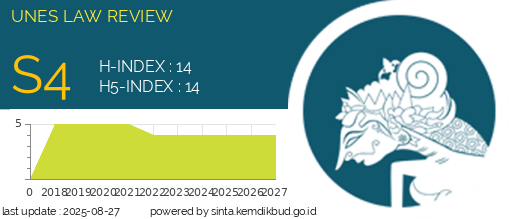Analisis Pemenuhan Unsur Kesengajaan (Opzet) dalam Tindak Pidana Pembunuhan (Studi Putusan Nomor 1/Pid.Sus-Anak/2020/PN KPN)
DOI:
https://doi.org/10.31933/unesrev.v6i4.1995Keywords:
Children, Death Penalty, Human RightsAbstract
A criminal act is something committed by an individual who deliberately violates the provisions of the Criminal Code Book II Chapter XIX (Articles 338 to Article 350) due to the loss of someone's life. One example of this case is the murder incident in Decision Number 1/Pid.Sus-Anak/2020/PN KPN. In this case, there was a child who murdered the victim with the motive of self-defense, because the victim asked for the perpetrator's belongings and had sex with the witness. The perpetrator was subject to a sentence based on Article 351 paragraph (3) of the Criminal Code regarding abuse resulting in death by the Panel of Judges. However, this caused a polemic because the perpetrator committed the murder by stabbing a knife into the victim's vital organs in the chest. The author uses a normative juridical approach to examine the judge's views regarding the fulfillment of the element of intent (opzet) in the crime of murder using secondary data obtained through literature study. Based on the research results, the judge's consideration of the use of Article 351 paragraph (3) of the Criminal Code in this decision was considered inappropriate because the judge simply did not review the jurisprudence, the opzet element in this incident, and only relied on the Criminal Code and subjective reasoning. In criminal law, it is important to consider the element of intent or opzet, even though the consequences are the same, namely the loss of the victim's life, the element of intent in each article is different. Article 338 of the Criminal Code requires the victim to lose their life, while Article 351 paragraph (3) of the Criminal Code only wants the victim to feel pain without wanting the victim to die.
Downloads
References
Gracia, G., Ramadhan, D. A., & Matheus, J. (2022). Implementasi Konsep Euthanasia: Supremasi Hak Asasi Manusia dan Progresivitas Hukum di Indonesia. Ikatan Penulis Mahasiswa Hukum Indonesia Law Journal, 2(1), 1–24. https://doi.org/10.15294/ipmhi.v2i1.53730
Ilyas, A. (2012). Asas-Asas Hukum Pidana : Memahami Tindak Pidana dan Pertanggungjawaban Pidana Sebagai Syarat Pemidanaan. Rangkang Education & PuKAP Indonesia.
Insani, N., & Octaviyanti, A. (2023). Opzet Sebagai Dasar Mens Rea Untuk Membedakan Delik Pembunuhan dan Penganiayaan Berat yang Menyebabkan Kematian. Rechtsregel : Jurnal Ilmu Hukum, 6(1), 77–82. https://doi.org/https://doi.org/10.32493/rjih.v6i1.34154
Irawati, A. C. (2019). Politik Hukum Dalam Pembaharuan Hukum Pidana (RUU KUHP Asas Legalitas). ADIL Indonesia Journal, 1(2), 1–12.
Koeswadji, H. H., Soeharyo, Mintoroem, H., & Woeryaningsih. (1984). Kejahatan terhadap Nyawa, Asas-Asas, Kasus, dan Permasalahannya 1984. Sinar Wijaya.
Lamintang, P. A. F., & Lamintang, F. T. (1997). Dasar-Dasar Hukum Pidana Indonesia. PT Citra Aditya Bakti.
Magistri, N. R. C., & Jaya, N. S. P. (2020). Tinjauan Yuridis Terhadap Perlindungan Hukum Korban Tindak Pidana Penusukan Dalam Peradilan Pidana. Jurnal Pembangunan Hukum Indonesia, 2(1), 82–101. https://doi.org/10.14710/jphi.v2i1.82-101
Mulyadi, L. (2007). Kekuasaan Kehakiman. Bina Ilmu.
Saruan, Y., Wongkar, V. A., & Tooy, C. S. (2022). Pertanggungjawaban Pidana Terhadap Kasus Pemerkosaan Disertai Pembunuhan Berencana. Lex Privatum, 10(2), 1–8.
Soekanto, S. (1983). Faktor-Faktor yang Mempengaruhi Penegakkan Hukum. RajaGrafindo Persada.
Soeridibroto, S. (2004). KUHP dan KUHAP. PT Raja Grafindo Persada.
Sudrajad, W., & Ma’ruf, U. (2017). Rekonstruksi Sebagai Upaya Mengungkap Tindak Pidana Pembunuhan Berencana (Studi Kasus Wilayah Hukum Polsek Banyumanik Semarang). Jurnal Hukum Khaira Ummah, 14(1), 1–6. https://doi.org/http://dx.doi.org/10.30659/jku.v14i1.1890
Syamsani, F. N., & Yudiantara, I. G. N. N. K. (2023). Analisis Terhadap Tindak Pidana Pembunuhan yang Dilakukan oleh Anak di Bawah Umur. Kertha Desa, 11(6), 2637–2650.
Yasin, M. (2016). Makna Kekhilafan Hakim atau Kekeliruan Nyata. Hukumonline.com. https://www.hukumonline.com/berita/a/makna-kekhilafan-hakim-atau-kekeliruan-nyata-lt5778a934e3ab2
Downloads
Published
How to Cite
Issue
Section
License
Hak cipta :
Penulis yang mempublikasikan manuskripnya di jurnal ini menyetujui ketentuan berikut:
- Hak cipta pada setiap artikel adalah milik penulis.
- Penulis mengakui bahwa UNES Law Review berhak menjadi yang pertama menerbitkan dengan lisensi Creative Commons Attribution 4.0 International (Attribution 4.0 International CC BY 4.0) .
- Penulis dapat mengirimkan artikel secara terpisah, mengatur distribusi non-eksklusif manuskrip yang telah diterbitkan dalam jurnal ini ke versi lain (misalnya, dikirim ke repositori institusi penulis, publikasi ke dalam buku, dll.), dengan mengakui bahwa manuskrip telah diterbitkan pertama kali di Jurnal UNES Law Review.


















